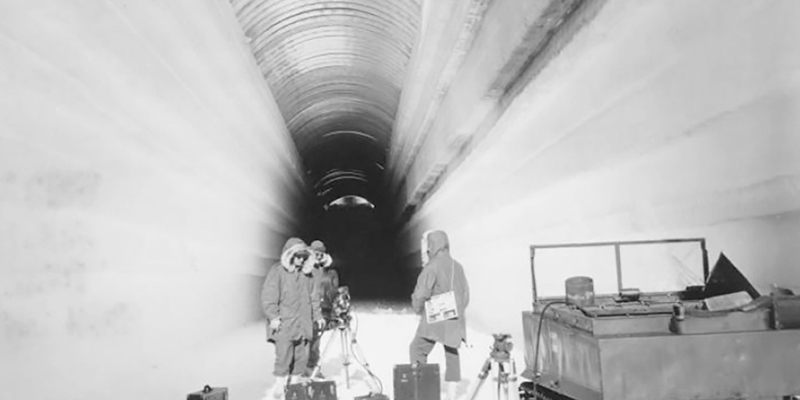This is the story of a scientific discovery but also a story of spies in which a top-secret military base, nuclear weapons, a lot of ice, a Danish refrigerator and a time capsule are interspersed.
A real time capsule.
It took place in the middle of the Cold War in one of the most discreet and inhospitable places on Earth.
Northwest Greenland was the ideal location to build a base where the US Army hid nuclear weapons a stone's throw from the USSR.
Not even the Danish authorities, under whose control Greenland was controlled, knew that the goal of the Americans in building a spectacular system of underground tunnels more than 3,000 kilometers long was to hide 600 nuclear missiles.
It was, of course, the 60s.
Officially it was said that Camp Century, nicknamed
the city under the ice
, was a scientific station
dedicated to polar research.
And it was not completely a lie because among the projects that were carried out, soil samples were taken that half a century later have turned out to be a treasure for science.
In 1966, the frozen Greenland cap was drilled 1.5 kilometers deep to extract an ice core about four meters long.
But the call Iceworm Project (
ice worm
) was a failure because the base tunnels quickly deformed, with the risk of landslides, and Camp Century was abandoned in 1967.
Andrew Christ / UVM Historic Photos and Film
The ice core collected in 1966 was transported by ship to a military laboratory in New Hampshire.
In the early 1970s, it was taken to a freezer at the University of Buffalo, where Professor Chester Langway and other researchers studied its various layers for studies of the Arctic climate.
In the 1990s, when two new underground ice samples were collected in another area of Greenland, the Camp Century core was transferred to Denmark, where it remained in a semi-forgotten freezer for several decades until it was moved to another freezer and Andrew Christ, Researcher at the University of Vermont, he became interested in him again.
That's when the surprise came: the frozen Arctic soil remains contained ancient, perfectly preserved plant remains that demonstrate that Greenland was covered by abundant vegetation, possibly a boreal forest, as the authors propose this week in this study published in the journal
Proceedings of the National Academy of Sciences (PNAS).
These plant debris trapped in the ice, small branches and leaves, are the
time capsule
that has allowed this team of researchers to
read
the climate history of Greenland, the region that currently worries the most due to the rapid acceleration of the thaw that It is occurring in recent years and is directly linked to the rise in sea level in other areas of the planet.
"Ice sheets normally pulverize and destroy everything in their path but we have discovered delicate perfectly preserved plant structures.
They are fossils but it seems they died yesterday.
It is a time capsule of life that existed in Greenland that we would not be able to find in somewhere else, "says Andrew Christ.
The samples were subjected to a wide variety of analyzes combining various technological instruments that were not available when they were removed from the ground.
For example, by studying its isotopes, they were able to determine how long that material had been exposed and how long it had been buried by snow.
The analysis of this team, of which scientists from the Universities of Columbia (USA) and Copenhagen are also part, reveals that during the last million years -probably several hundred thousand years ago-, the territory that today occupies Greenland was free of ice.
A conclusion that would confirm what scientists have long believed: that
Greenland has completely melted during the warm periods of history for natural reasons
, and has frozen again.
For the authors, understanding the past of the icy areas of the planet, the Earth's refrigerators, is crucial to try to respond to the accelerated warming that our planet is now experiencing due to the action of man.
"This is not a problem for the 1920s, but an urgent problem for the next 50 years," says Paul Bierman, a researcher at the University of Vermont.
For his part, Christ believes that this research makes it clear that the Greenland ice sheet is not as permanent as previously thought: "Our study shows that it is much more sensitive to climate change than we thought and we know that global warming caused by humanity far exceeds the natural rate of warming. "
According to the criteria of The Trust Project
Know more
See links of interest
Work calendar
Manchester United - West Ham United
Real Oviedo - Leganés
Milan - Napoli
Seville - Real Betis
Barcelona - Huesca

